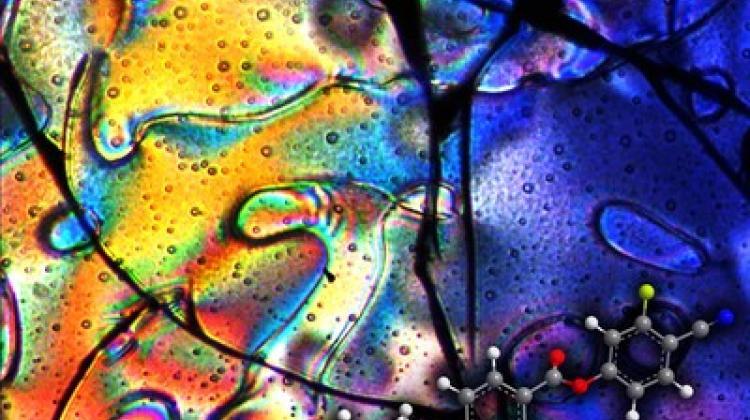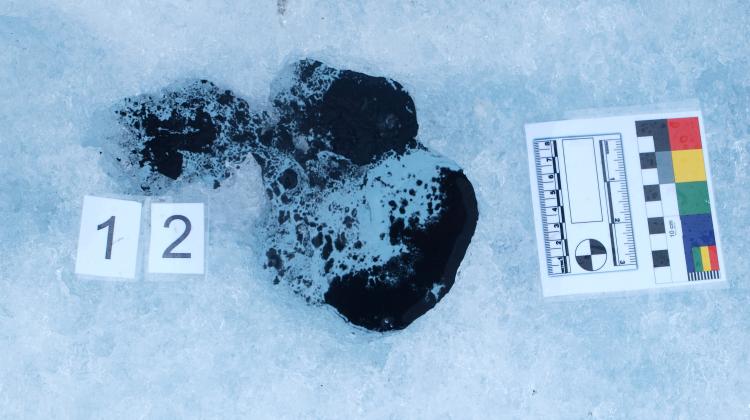Liquid crystals in nanopores produce surprisingly large negative pressure
 The negative pressure produced by liquid crystals in nanopores can significantly exceed 100 atmospheres. In the picture, the glass of the nematic phase of liquid crystal studied by scientists from the Institute of Nuclear Physics of the Polish Academy of Sciences in Kraków. Source: Institute of Nuclear Physics PAN
The negative pressure produced by liquid crystals in nanopores can significantly exceed 100 atmospheres. In the picture, the glass of the nematic phase of liquid crystal studied by scientists from the Institute of Nuclear Physics of the Polish Academy of Sciences in Kraków. Source: Institute of Nuclear Physics PAN
Negative pressure rules not only the Universe or quantum vacuum. Researchers at the Institute of Nuclear Physics PAS in Kraków presented a method was that allowed to estimate, for the first time, the amount of negative pressure in spatially limited liquid crystal systems.
Negative pressure is common in nature an it exists at many scales. In the plant world, attractive intermolecular forces (and not pushing thermal motions) guarantee the flow of water to the top parts of each tree taller than ten meters. At the quantum scale, the pressure of virtual particles of a false vacuum leads to the creation of an attractive force, for example between two parallel metal plates (the Casimir effect). At the scale of the Universe, the cosmological constant is responsible for the accelerating expansion of space-time.
"The fact that negative pressure appears in liquid crystals that fill the nanopores, has been known. But it was not known how to measure the value of this pressure. While we can not do it directly, we have proposed a method that allows to reliably estimate this pressure" - says Dr. Tomasz Rozwadowski from the Institute of Nuclear Physics of the Polish Academy of Sciences in Kraków, the lead author of the publication in the Journal of Molecular Liquids (https://doi.org/10.1016/j.molliq.2019.01.106). The representatives of the institute informed about the research in a release.
Kraków physicists looked at the liquid crystal known as 4CFPB, made up of 1.67 nm long particles, with a molecular diameter of 0.46 nm.
In their experiments, the researchers looked at changes of various parameters of the liquid crystal (including dielectric absorption and dispersion). Measurements allowed to conclude that pressure increase was accompanied by a slowing down of molecular motions. But liquid crystal molecules of placed in nanopores moved the faster, the narrower were the channels they were in. The data also showed that the density of liquid crystal molecules increased with increasing pressure, while it decreased in nanopores.
Another changing parameter were the temperatures, in which the liquid crystal passed from the liquid isotropic phase (with molecules arranged chaotically in space) to the simplest liquid crystalline phase (nematic; molecules are still chaotically arranged, but position their long axes in the same direction), and then to a glassy solid phase. As the pressure increased, the temperatures of the phase transitions increased. In nanopores - they decreased.
"When increasing the pressure, all the parameters of the liquid crystal we examined changed inversely compared to the nanopores with decreasing diameters. This suggests that the conditions in the nanopores correspond to reduced pressure. And since the liquid crystal molecules in the tubules try to push their walls as if they are expanding, we can talk about the negative pressure relative to the atmospheric pressure, which squeezes the walls" - Rozwadowski says.
The observed changes of physical parameters allowed to for the first time estimate the value of negative pressure in the liquid crystal filling the nanopores. The linear nature of these changes suggests that the negative pressure in nanopores can reach nearly -200 atmospheres. This value is an order of magnitude greater than the negative pressure responsible for water transport in trees.
"Our research is basic, it provides information about the physics of phenomena occurring in liquid crystals inside nanopores of different diameters. But liquid crystals have many applications, for example in displays, optoelectronics and medicine, so each new description of how these substances behave at the nanoscale in such specific spatial conditions can carry practical information" - notes Dr. Rozwadowski.
Experiments without nanopores, under normal and elevated pressure conditions (up to about 3000 atmospheres), were carried out at the University of Silesia in Katowice. The systems in silicon diaphragms with non-intersecting nanopores with diameters of 6 and 8 nanometers were studied at the Leipzig University (Germany).
Research on liquid crystals under spatial limitations was financed with the SONATA grant from the National Science Centre.
PAP - Science in Poland
lt/ ekr/ kap/
tr. RL
Przed dodaniem komentarza prosimy o zapoznanie z Regulaminem forum serwisu Nauka w Polsce.
















